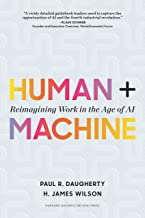By William Carmichael
Last month, I reviewed the first of three current bestsellers on the topic of Artificial Intelligence (AI) and did so from a perspective of AI as a human resource’s change agent within an organization. I touched on how AI has become a transformational inevitability for both business and industry and how the organizational dynamics of AI directly impact that organization’s global success. That inherently, changes needed must be built-in and ultimately become ontologies which are frameworks for representing shareable and reusable knowledge across a domain.
In this second review, I will look specifically at AI as the next paradigm shift for organizational growth. For this, Human + Machine: Reimagining Work in the Age of AI by Paul R. Daugherty and H. James Wilson show that the essence of the AI paradigm shift is the transformation of all business processes within an organization. It also establishes a much-needed benchmark for those of us still new to AI. And once again, HR is right there.
What is AI and Our Role in it?
For HR and legal practitioners, understanding AI and how it applies to our individual roles may seem daunting at first, yet it is surprisingly logical. In Human + Machine, Daugherty and Wilson define AI as “systems that extend human capability by sensing, comprehending, acting, and learning.” Simple enough but where exactly do we as employees, fit into these systems? Or, if machines replace much of the work done by humans, what will be the (new) work for humans to do? According to the authors, “The key to understanding AI’s current and future impact is its transformation of business processes.” They go on to say, “A widespread misconception is that AI systems, including advanced robotics and digital ‘bots’ will gradually replace humans in one industry after another. . . That may be true for certain jobs, but what we’ve found in our research is that although AI can be deployed to automate certain functions, the technology’s greater power is in complementing and augmenting human capabilities. And there is one new job that will likely be needed, and filled; HR Directors for machines, providing training; correcting; firing; re-purposing; performance reviews for our machines.”
“Today, 61% of activities in the missing middle require employees to do different things and to do things differently,” the authors report. Therefore, companies must reimagine their work processes and “reskill their employees.” Employees’ new jobs include training data models and “explaining and responsibly sustaining an AI system’s performance.” Doing things differently means employees’ “using amplification, interaction, and embodiment to get a job done with superhuman performance.” When humans and machines do what they do best, “the result is a virtuous cycle of enhanced work that leads to productivity boosts, increased worker satisfaction, and greater innovation.” According to the authors’ research, “companies that use AI to augment their human talent while reimagining their business processes achieve step gains in performance, propelling themselves to the forefront of their industries.
Why this is a Must Read
Three reasons:
- This book is an excellent primer on where things stand now in the development of AI.
- This book will help us think about the human place and role in work in the world of rising AI capabilities.
- This book will inspire us to think about what is possible in ways that we have not yet considered.
Based on the authors’ experience and research with 1,500 organizations, the book reveals how companies are using the new rules of AI to leap ahead on innovation and profitability, as well as what we can do to achieve similar results. It describes six entirely new types of hybrid human + machine roles that every company must develop and it includes a “leader’s guide” with the five crucial principles required to become an AI-fueled business.
Structure and Layout
Written in two parts, at 215 pages, Human + Machine: Reimagining Work in the Age of AI, has the look and feel of a user-friendly technical guide and one I recommend as a linear read. Figures, charts, and author observations also help support points throughout the book, as does an excellent technical index. Well researched, readers will appreciate the insight and clarity our authors bring to AI in our lives.
| Part | Chapter | Title | Description |
| Introduction | What’s Our Role in the Age of AI? | Introduces a few key concepts of the book, first setting the context by describing three historical waves of business transformation: | |
| 1 | The Self-Aware Factory Floor: AI in Production, Supply Chain, and Distribution | Explores AI in manufacturing and supply chain, in factories where humans are working in partnership with smaller, more adaptable, context-aware robots. They describe how flexible, highly productive human-machine teams “fulfill customized orders and handle fluctuations in demand.” This chapter also concludes with a brief history of AI. | |
| 2 | Chapter 2: Accounting for Robots: AI in Corporate Functions | Focuses on the role of AI in business processes and back-office operations. Daugherty and Wilson affirm: “AI technology can help filter and analyze streams of information from a variety of sources and enable the automation of tedious, repetitive tasks as well as the augmentation of human skills and expertise.” The authors consider how to determine what processes to change and how much to change—even to the extent of redefining an entire industry—and explore reimagining processes around people. The chapter concludes with an excellent glossary of the many AI technologies in use today—covering the machine-learning component, AI capabilities, and AI applications. | |
| 3 | The Ultimate Innovation Machine: AI in R&D and Business Innovation | Describes “how companies are using AI in research and development. In each major step of the R&D process—observation, hypothesis generation, experiment design, and results analysis—AI technologies can lead to increased efficiencies and markedly improved outcomes.” Sidebars discuss learning from failure, AI in product and service design, responsible AI—including ethics as a precursor to discovery—and AI in healthcare and life sciences. | |
| 4 | Say Hello to Your New Front-Office Bots: AI in Customer Service, Sales, and Marketing | Looks at the impacts of machine-learning technologies on customer service, sales, and marketing. For example, Amazon’s Alexa, Apple’s Siri, and Microsoft’s Cortana “are increasingly becoming the digital embodiment of those companies’ well-known brands.” Sidebars look at AI in retail sales and AI in the sales and marketing process. | |
| 5 | Rearing Your Algorithms Right: Three Roles Humans Play in Developing and Deploying Responsible AI | Describes “how humans are helping machines to extend and amplify their capabilities.” This chapter considers in depth the ways in which humans can complement machines by training, explaining, and sustaining them. It also describes specific jobs and responsibilities for trainers, explainers, and sustainers. The authors state, “Machine learning, when integrated into processes, will lead to a variety of brand-new jobs. … Employees will be needed to design and train algorithms, to explain the algorithms used, and to do so in a way that sustains the algorithms within a process.” | |
| 6 | Super Results from Everyday People: Three Ways AI Unleashes New Levels of Productivity | Discusses the superpowers that AI can give humans, describing three types of augmentation through which “people are achieving huge performance boosts by working with AI technologies that dramatically improve their human capabilities; they amplify, interact, and embody new human potential. These new types of human-machine relationships are helping people … by offloading tedious tasks and by enabling them to perform their work faster and more effectively through the expert guidance, advice, and support from AI systems.” The chapter describes specific jobs for AI agents that amplify, interact, and embody. | |
| 7 | A Leader’s Guide to Reimagining Process: Five Steps to Getting Started | Discusses the challenges that AI introduces, which “require different, new responses from management and leadership.” The authors consider the first four of five crucial steps that executives must take to facilitate the reimagining of processes. | |
| 8 | Extending Human + Machine Collaboration: Eight New Fusion Skills for an AI Workplace | Looks at the fifth step that executives must take as human-machine collaborations become more prevalent. Daugherty and Wilson consider the future of work and hiring for and developing eight fusion skills that are essential to an AI workplace. | |
| Conclusion | Creating Your Future in the Human + Machine Era | Provides a clear, perceptive analysis of the current state of AI in a variety of business domains—and numerous, inspiring examples of businesses at the cutting edge of AI. Daugherty and Wilson, make a compelling case for their vision of possible future applications of AI that would transform business, and they offer practical advice for organizations that are ready to embrace the future that only partnerships between humans and machines can deliver. |
Who Will Benefit Most from This Book?
Human Resource Professionals, Corporate Trainers, Information Officers, Senior Management
About the authors:
Paul R. Daugherty is the Chief Technology and Innovation Officer of Accenture. He leads Accenture’s AI Initiatives, as well as its R&D facilities around the world. H. James Wilson is Managing Director of Information Technology and Business Research at Accenture Research.

William Carmichael, Ed.D
Professor | Strayer University
william.carmichael@strayer.edu
www.strayer.edu
